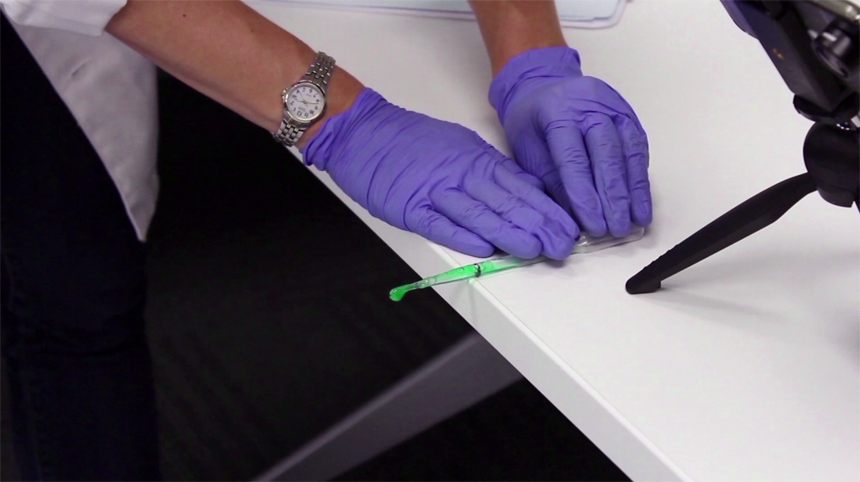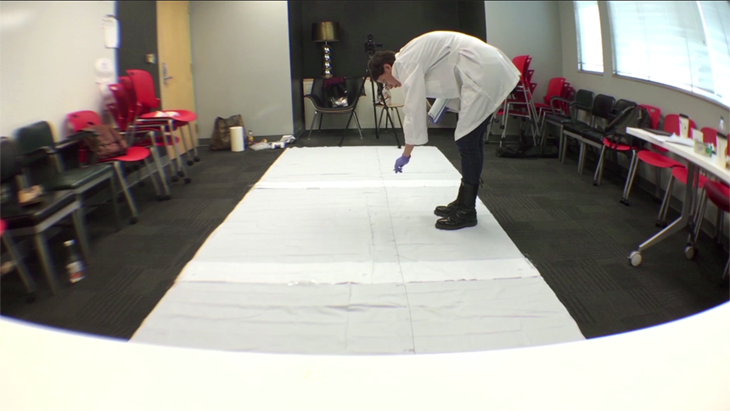Snot Science: Taking mucus to the next level
Data needs to be interpreted and compared to other studies to understand its meaning

I squirted thick and thin "snot" for my experiment. But that’s not the only way to look at the science of sneezing.
Explainr
This article is one of a series of Experiments meant to teach students about how science is done, from generating a hypothesis to designing an experiment to analyzing the results with statistics. You can repeat the steps here and compare your results — or use this as inspiration to design your own experiment.
When a person sneezes, they send tiny (or not so tiny) droplets of snot into the air. If they have a cold or influenza, the mucus they spray can contain viruses that could infect other people. So how far away should a sneeze-ee stand from a sneeze-er to avoid getting exposed?
In our first-ever DIY Science video, I performed an experiment to answer that question. In two previous blog posts, I laid out exactly what I didand how I analyzed my results. Here, I’ll explore how my results compare to those of other scientists who have also studied snot. I’ll look at where my experiment may have gone wrong and what I might have done better. Finally, I’ll list a few ideas for what else you might do if you conduct your own snot science.
In my experiment, I wanted to figure out how far away someone should stand to avoid getting hit by a sneeze spray. I decided to compare two types of boogers — thick and thin. For my thin snot, I used colored water as a stand-in. To simulate thick snot, I made a viscous mixture of corn syrup and gelatin. I squirted both types onto a tarp to see how far they flew.
As I had hypothesized, thick boogers did not fly as far as thin ones. Thin mucus drops flew an average of 302 centimeters (or almost 10 feet), while thicker drops flew an average of 110 centimeters (or 3.6 feet). Thick snot also tended to form fewer drops, and those drops concentrated closer to the sneeze-er.
What do other studies say about snot?
I’m not the first person to study snot. I didn’t even invent the experiment entirely on my own. I adapted a demonstration on NPR’s Science Friday. Scientists have also studied snot in far more detail. They have studied the size of droplets created by coughing and sneezing. They’ve studied whether people are more likely to be infected by drops big enough to feel and see, or whether infection occurs when they inhale tiny droplets.
Scientists have even exposed sneezes to study with high-speed cameras. Lydia Bourouiba is a mathematician at the Massachusetts Institute of Technology in Cambridge. She and her group have been studying the math and physics of the goop sprayed out by coughs and sneezes. Their goal is to use the knowledge of snot spatter to limit the spread of disease. In one study, Bourouiba filmed people sneezing and coughing to see where their snot went. She also created mathematical models to predict how fluids spray. And she squirted fake snot into tanks of salty water to explore how clouds of droplets from a sneeze behave.
These tests showed that droplets tend to travel with each other in a cloud. The cloud allows the droplets to drift much farther than they might on their own — up to eight meters (26 feet)! The group published its findings in 2014 in the Journal of Fluid Mechanics.
That’s your average sneeze, but how might that change with different kinds of snot? Scientists have studied that, too. Gustavo Zayas is a doctor who also does pulmonary research — he studies how the lungs work — at the University of Alberta in Edmonton, Canada. In 2005, he published an experiment examining how the thickness of droplets in a cough affects how far droplets scatter in the air. If chemicals were added to fake mucus to make it thicker, more mucus came out during a cough — but it didn’t go far. It didn’t become the fine spray that could infect people at a distance. He shared his results in the journal BMC Pulmonary Medicine.
How does my study compare?
My snot samples didn’t fly nearly as far as Bourouiba’s. Her snot splattered out 8 meters (26 feet), while the average of my thin mucus was only around 3 meters (almost 10 feet). Making my boogers thicker did decrease the distance they could fly, as in Zayas’ study.
Different experiments will achieve different results, of course. But comparing my data to those from other studies helps to expose some of my experiment’s limitations. These are the factors in my study that may have prevented me from discovering what’s really going on when someone sneezes.
Story continues below image.

Among my study’s limitations:
My dropper isn’t a person’s nose. It doesn’t spray fluid in the same volume or at the same pressure as a real nose might.
Snot isn’t either thick or thin; it’s usually a mixture. I only compared two extremes.
My recipe for thick snot didn’t produce a consistent product. The first time I made it, the snot was relatively thin. I then had to make the snot again, because as the mixture cooled down, my snot got thinner and thinner. When I made the second batch halfway through my experiment, it was much thicker.
How much thicker? I don’t know! I didn’t measure the fluid’s viscosity — its resistance to flow.
I counted the number of droplets resulting from my different squirts, but I didn’t measure their size.
I only counted the drops that I could see. Real sneezes squirt out some drops that are much, much smaller.
Correcting for some of these factors could have improved my experiment. In fact, there are more. That makes my experiment sound like a total failure! But it’s not.
Well ok, maybe it is a little.
But I was able to examine the difference between thick and thin snot. And failure is an important part of science. Finding out where I made mistakes helps me learn how to correct them. It gives me the opportunity to try the experiment again and fix problems that I encountered the first time. For example, I could alter my snot recipe to make sure I didn’t have to make it twice. I could weigh drops of my thick and thin snot to measure their viscosity. I could even measure the size of the droplets as they spatter.
These limitations are a good reason to repeat my experiment. They are also a reason for other people — like, say, you — to try this experiment, too. The more people who perform this experiment, the more opportunity there is for someone to replicate my results. Scientific findings aren’t generally accepted unless many scientists do an experiment and get similar results.
Snot Science: Beyond sneezes
I would love for more people to try my experiment and let me know what kind of results they get. (You can leave a comment on YouTube or drop me a line on Twitter.) But why just replicate an experiment that someone has already done? Why not make up your own? Here’s a few ideas for how you might alter — and even improve — my experiment:
Compare drop size and distance: In my limitations, I mentioned I didn’t measure drop size. Why not measure the thickness of the liquid and the size of the droplets. How does droplet size affect how far the drops flew?
Compare different snot types: I used one recipe for making my snot. But there are many other recipes out there. Some use different amounts of gelatin and corn syrup, while others use sodium borate — a white powder used in cleaning — mixed with glue. You can try different recipes, with different amounts of water, gelatin, sodium borate or glue. You can measure how changing the amounts of the different components of your recipe changes the thickness of your boogers — and how that affects how far snot will fly.
Put a tissue on it! The Centers for Disease Control and Prevention recommend that you cover your nose and mouth when you sneeze. That might get the bigger boogers, but does it stop the spread of germs? Try comparing snot rockets with and without tissues in front of them.
Or you can come up with your own question, form a hypothesis and start your own unique study on the science of snot.
SSP/Explainr
Follow Eureka! Lab on Twitter







